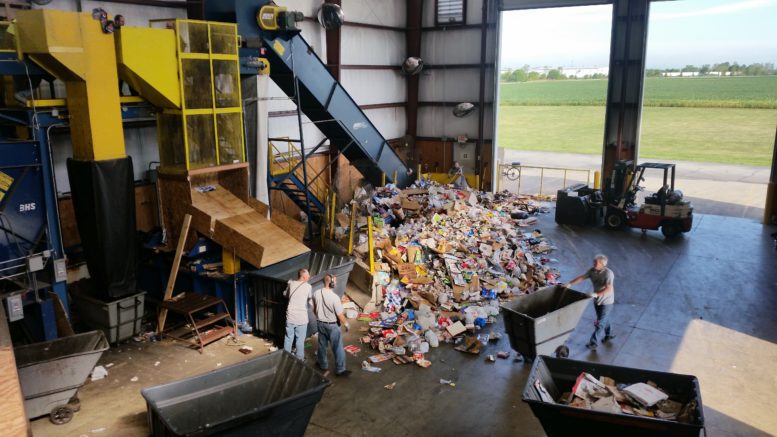By JAN LARSON McLAUGHLIN
BG Independent News
Recycling services that Bowling Green citizens have come to expect are at risk of being trashed unless the city subsidizes the program more or finds a less expensive provider.
A combination of market changes, declining newspaper products, and China’s refusal to buy American recyclables is creating an upheaval in recycling programs nationwide.
“We have a very long history with this,” Municipal Administrator Lori Tretter said about the Bowling Green Recycling Center during a meeting of City Council’s Committee of the Whole Tuesday evening.
“When the system was different, you made money from recyclables,” Tretter said. “It’s a very different story now.”
Citizens of Bowling Green have always been supportive of recycling. Last year 700 tons of recyclables were collected curbside, and another 1,000 tons were left at the drop-off location. So that makes it difficult to put the discussion in terms of dollars and cents, Tretter said.
“It’s really hard to get up here and talk about the economics of it,” she said.
But officials at the recycling center have told city officials that they cannot keep operating the facility at the current annual rate from the city.
“The markets are as low as they’ve ever been,” said Ken Rieman, chairman of the Bowling Green Recycling Center. “I haven’t seen it this bad in 40 years.”
That has resulted in the center facing a loss of $10,000 to $12,000 a month, Rieman said.
“We’re operating on reserves,” he said. “I don’t see it going back to the model where materials pay their way to market.”
Newspaper used to be the real money-maker in recycling, Rieman explained. In 2009, the center took in 1,000 tons of newspaper. It still brings in $100 a ton – but the amount of newspaper has shrunk down to about 300 tons this year. And if it’s mixed with magazines, its worth is cut to about $10 a ton.
“Newspaper is never coming back,” Rieman said.
“We’re at the mercy of what happens in the markets,” he said.
But the funding requested by the recycling center is a steep increase – from $80,000 to $215,000 a year.
The city’s current agreement with the recycling center was signed in 2008 and has been renewed every two years.
“The economics of recycling have changed in 11 years,” Tretter said.
That deal has the city paying the recycling center $80,000 annually. A portion of that comes from Wood County’s per capita funding from its solid waste management program. That amount was recently bumped up by the county from $30,000 to $45,000 a year.
The city also pays the landfill costs for all the trash that is put into recyclable containers. That adds up to about $5,000 a year.
Bowling Green officials have tried to cut down on the trash being put in recyclable containers by installing cameras on all the recycling trucks.
“We can talk to that person almost immediately,” said Amanda Gamby, the city’s sustainability coordinator. “To see if we can’t change some of that behavior.”
On the first offense, residents receive warnings, followed by fines, and finally the loss of their recycling privileges if they continue to put trash in the recycling bins.
“We see that as a last ditch resort,” Gamby said.
But garbage continues to get into recyclable loads – which also leads to delays in the sorting process, clogged up lines, and contamination of the products. Top on the list of problems are bagged recyclables or garbage, shipping envelopes and packing materials, and “wish-cycling.”
“You’re standing at the recycling bin and you really want it to be recycled,” Gamby said. But she stressed, “when in doubt, throw it out.”
Items like dead animals and dirty diapers are also put in with recyclables – which all have to be hand sorted.
“There’s really no excuse for that,” Gamby said.
Meanwhile, the markets have tanked, and recyclables are sitting on docks with no buyers.
Even Gamby, a self-described “glass half full” kind of person, is concerned.
“This is probably the worst I have seen it,” she said. The U.S. is at a “critical point” in its recycling. “I don’t think any of us can definitively stand here and say things are going to get better.”
Some communities are debating how much longer they can subsidize their recycling programs, Gamby said.
“How much are you willing to pay,” she said. “For some communities, they have no choice.”
If entering a new contract with the Bowling Green Recycling Center, city officials want it to include a 30-day notice for the city when certain materials will no longer be accepted, Tretter said.
Little notice was given when the center stopped taking glass and then later books. Glass is now again accepted at the drop-off thanks to a subsidy from Wood County.
Tretter asked City Council to allow the administration to seek other bids to accept city recyclables. Council agreed.
“I understand and I accept the economics of recycling are changing,” City Council President Mike Aspacher said.
“Obviously, they provide a service to our community that is beneficial, and they should be compensated for that,” he said.
The city has “an obligation to do what we can to recycle,” Aspacher said.
Council member Sandy Rowland agreed that city residents count on recycling services.
“It’s very shocking,” Rowland said. “Our residents do want recycling. They expect that. We have to do something.”
Aspacher said Tuesday’s meeting will be “the first of what will be many. We’ve got to figure it out.”





